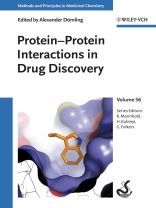Treating protein-protein interactions as a novel and highly promising class of drug targets, this volume introduces the underlying strategies step by step, from the biology of PPIs to biophysical and computational methods for their investigation.
The main part of the book describes examples of protein targets for which small molecule modulators have been developed, covering such diverse fields as cancer, autoimmune disorders and infectious diseases. Tailor-made for the practicing medicinal chemist, this ready reference includes a wide selection of case studies taken straight from the development pipeline of major pharmaceutical companies to illustrate the power and potential of this approach.
From the contents:
* Prediction of intra- and inter-species protein-protein interactions facilitating systems biology studies
* Modulators of protein-protein interactions: The importance of Three-Dimensionality
* Interactive technologies for leveraging the known chemistry of anchor residues
* SH3 Domains as Drug Targets
* P53 MDM2 Antagonists: Towards Non Genotoxic Anticancer Treatments
* Inhibition of LFA-1/ICAM interaction for treatment of autoimmune diseases
* The PIF-binding pocket of AGC kinases
* Peptidic inhibitors of protein-protein interactions for cell adhesion receptors
* The REPLACE Strategy for generating Non-ATP competitive Inhibitors of Cell-Cycle Protein Kinases
and more
Jadual kandungan
Preface
PROTEIN-PROTEIN INTERACTIONS: AN OVERVIEW
Introduction
Role of PPIs in Human Physiology
Regulation of PPIs
Structural Features of PPI Interfaces
Identification of PPI Inhibitors
Conclusions and Outlook
PREDICTION OF INTRA- AND INTERSPECIES PROTEIN-PROTEIN INTERACTIONS FACILITATING SYSTEMS BIOLOGY STUDIES
Introduction: Relevance of Interactome Studies to Disease and Drug Discovery
Our Current Knowledge of Interactomes Identified from Experiments is Incomplete
Reliability of Interactions Identified Experimentally
Computational Methods for PPI Prediction
Sources of Biological Data in Use to Predict PPIs
Survey of Current Interactomes
MODULATORS OF PROTEIN-PROTEIN INTERACTIONS: IMPORTANCE OF THREE-DIMENSIONALITY
Introduction
Study
Discussion
Summary
A LEAP INTO THE CHEMICAL SPACE OF PROTEIN-PROTEIN INTERACTION INHIBITORS
Introduction
Types of Interaction
Properties of the Interface
Orthosteric versus Allosteric Modulation
Leap into the i PPI Chemical Space
Case Study
Conclusions
INTERACTIVE TECHNOLOGIES FOR LEVERAGING THE KNOWN CHEMISTRY OF ANCHOR RESIDUES TO DISRUPT PROTEIN INTERACTIONS
Introduction
Druggable Sites in PPIs
Structure-Based Library Design – A Powerful Alternative to High-Throughput Screening
New MCR Chemistry to Design PPI Antagonists
Virtual Screening
New Interactive Modeling Techniques for Medicinal Chemists
New Ideas: Hit Rate Validation of Achor-Centered Screening of p53/MDM2/4
Summary
SH3 DOMAINS AS DRUG TARGETS
Introduction
Structure
Variability
SH3 Binding Motifs
Selectivity
Drug Target Selection
Inhibition Strategies: Peptides and Peptoide Inhibitors
Small-Molecule Inhibitors
Conclusions
p53/MDM2 ANTAGONISTS: TOWARDS NONGENOTOXIC ANTICANCER TREATMENTS
Introduction
p53/MDM2 PPI is Characterized by Many Cocrystal Structures
Nutlins: First-In-Class MDM2 Antagonists
Johnson & Johnson: Benzodiazepines
Amgen: Chromenotriazolopyrimidines & Piperidones
University of Michigan: Spirooxindole
University of Pittsburgh: Ugi Based Compounds
University of Newcastle: Some Scaffolds With No Structural Biology Information
Outlook
INHIBITION OF LFA-1K/ICAM INTERACTION FOR THE TREATMENT OF AUTOIMMUNE DISEASES
Introduction
Integrin Structure and Activation
Direct Inhibition of the LFA-1/ICAM Interaction
Allosteric Inhibitors of the LFA-1/ICAM Interaction – IDAS Site
Summary
THE PIF POCKET OF AGC KINASES: A TARGET SITE FOR ALLOSTERIC MODULATORS AND PROTEIN-PROTEIN INTERACTION INHIBITORS
Introduction
Discovery and Physiological Functions of the PIF Pocket
Properties of the PIF Pocket Relevant to Drug Development
Small-Molecule PIF Pocket Ligands
Potential Supportive Effects Enhancing the Cellular Activity of PIF Pocket-Binding Modulators
Conclusions
RETOSIBAN AND EPELSIBAN: POTENT AND SELECTIVE ORALLY AVAILABLE OXYTOCIN ANTAGONISTS
Introduction
Aryl-2, 5-DKP Template Discovery and Initial Structure-Activity Relationship Studies
Synthesis of the RRR and RRS 6-Indanyl-3-isobutyl-7-aryl-2, 5-DKP Secondary Amides
Comparison of Crystal Structures of Oxytocin and 2, 5-DKPs
Pharmacokinetics and Property-Based Design
In Vivo Potency of 2′, 4′-Diflurophenyl Dimethylamide 22
Synthesis of Tertiary Amides
Summary of Lead Oxytocin Antagonist 2′, 4′-Diflurophenyl Dimethylamide 22
Further Modifications, Five- and Six-Membered Heterocyclic Derivatives
Five-Membered Heterocyclic Derivatives and Retosiban
Summary of Lead Oxytocin Antagonist Retosiban 56
Six-Membered Heterocyclic Derivatives and Epelsiban
Summary of Lead Oxytocin Antagonist Epelsiban 77
Comparison of Lead Compounds
Conclusions
PEPTIDIC INHIBITORS OF PROTEIN-PROTEIN INTERACTIONS FOR CELL ADHESION RECEPTORS: RGD PEPTIDES AND BEYOND
Introduction
From the Discovery of the RGD Motif in FN to the First Selective Cyclic RGD Peptide
N-Methylation of c(RGDf V): Cilengitide and Beyond
iso DGR Sequence as a New Integrin-Binding Motif
Conclusions
REPLACE STRATEGY FOR GENERATING NON-ATP-COMPETITIVE INHIBITORS OF CELL CYCLE PROTEIN KINASES
Introduction
Inhibition of CDKs Through the
Mengenai Pengarang
Alexander Dömling studied Chemistry and Biology at the Technical University Munich, Germany. After obtaining his Ph D under the supervision of Ivar Ugi, he spent a postdoctoral year at the Scripps Research Institute in La Jolla (USA) in the group of Nobel Laureate Barry Sharpless. In 2004 he performed his habilitation at the Technical University of Munich. Since 2006 he teaches and performs research at the University of Pittsburgh in the Department of Pharmacy with secondary appointments in Chemistry and Computational Biology. In 2010 he became full professor receiving his tenure in Pittsburgh. Since 2011 he is chairing the department of Drug Design at the University of Groningen/The Netherlands. Dr. Dömling is founder of several biotech companies, including Morphochem and Carmolex. His research centers around the discovery of antagonists of protein-protein interactions and other biologically active compounds in the therapeutic areas of oncology, infectious and neglected tropical diseases using ?out-of-the-box? software tools and multicomponent reaction chemistries.












